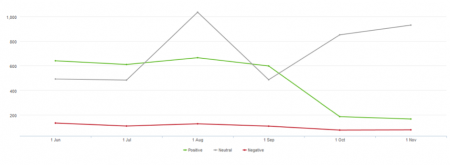This article is a guest post from Joel Windels, Community Manager for Brandwatch, Europe’s leading social media monitoring tool.
The increase in technology over the past two decades has also seen a rise in the number of acronyms and jargon. In line with this, the proliferation of the web and internet technologies has resulted in an online landscape littered with SEO, SEM, SMO, SMM and SMEs.
In true social media fashion, we have decided to take a look at how SMM (social media monitoring) tools can be used to help SMEs (small and medium enterprises).
At first glance, it can appear that monitoring tools are prohibitively expensive to smaller companies and that the relatively low volume of online mentions about their brand renders such tools ineffective.
This, however, is not always the case, and there are multiple ways in which SMM tools can benefit companies with double-digit staff rolls.
This software is usually associated with large datasets and analysis, though most packages also feature CRM (customer relationship management) elements.
By tracking a brand and key terms surrounding it, companies can isolate individual mentions about them. Once these mentions are listed, it’s easier for the business to respond accordingly to each one all from within the app, whether that be a forum, Twitter or another web platform.
This allows for front-line customer service, and brands can remedy problems, address issues and help people at the source of the complaint before the next steps are taken by the consumer, leaving the customer happy that their problem has been dealt with unexpectedly promptly even before they have formally taken it to the customer service department.
This system also grants businesses the option to search for outbound leads. Using SMM tools, queries can be arranged so that all mentions of terms relating to a potential lead can be flagged. An independent British cinema in the midlands could have queries set up for ‘films in Milton Keynes’ or even ‘Odeon Milton Keynes’ to poach upon potential customers that are posting about visiting ‘a’ cinema.
This can obviously be adapted depending on the industry, but it’s easy to see how new lead opportunities can be found using SMM.
Another important use of these programs is the possibilities that are provided when tracking the success of targeted campaigns. Even if the company performs the bulk of their activity offline, a key metric of success can be ascertained from social media.
A lawnmower manufacturer can listen online to the buzz surrounding the release of their latest model, which may prove to show that it’s too small, or even something otherwise seen as positive, like its low price. The data gained from SMM can often display fascinating insights into the reception of a product and can demonstrate to companies a wealth of information with amazing clarity.
Sentiment analysis is also a field gaining a lot of traction recently for its ability to determine the positivity of an online mention. It’s a misunderstood technology and many believe it is designed to work 100% of the time with perfect accuracy.
Unfortunately this is not the case, but here at Brandwatch we are pioneering techniques that aim for around 60-70% accuracy using rule-based classifiers and machine learning. This means that as the data is crawled and compiled, it also assigned a sentiment, in Brandwatch’s case either positive, negative or neutral.
Using the automated sentiment analysis as well as manual mark-up of the data, trends can be identified – does a goodwill campaign result in a peak in positive tweets, for example?
Other reasons SMEs can make good use of SMM tools are the ability to spot key advocate of a brand, as well as the major influencers in each industry, which can then be used in marketing and sales strategies.
Whether it’s anything we’ve listed in this article, or it’s just keeping an eye on your competitors, or even simply using it as a broadcasting platform, social media monitoring tools can offer a whole host of advantages to SMEs in order to get ahead in their market.



